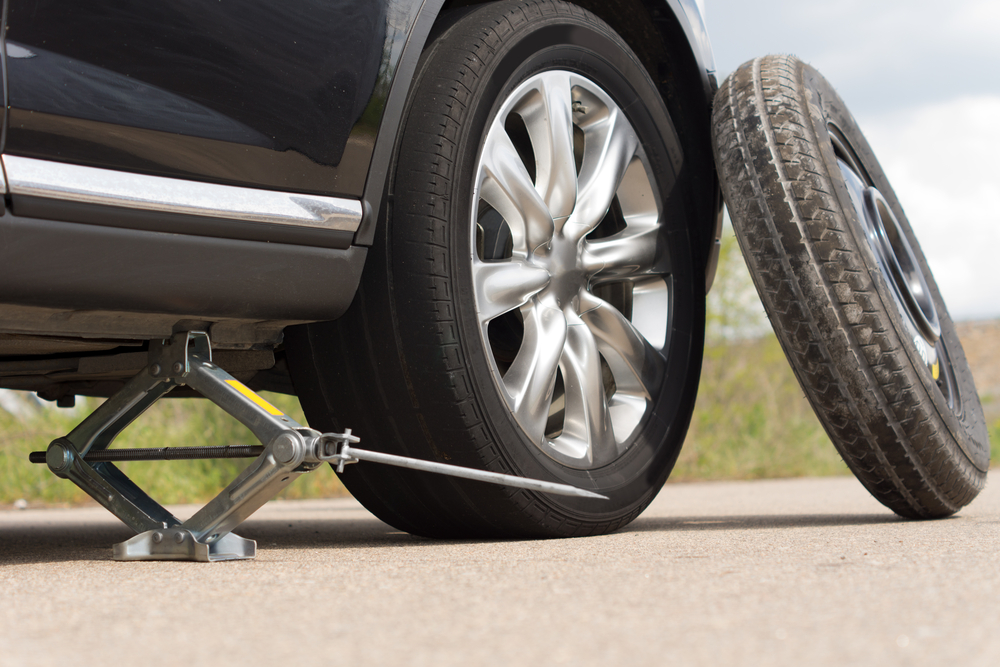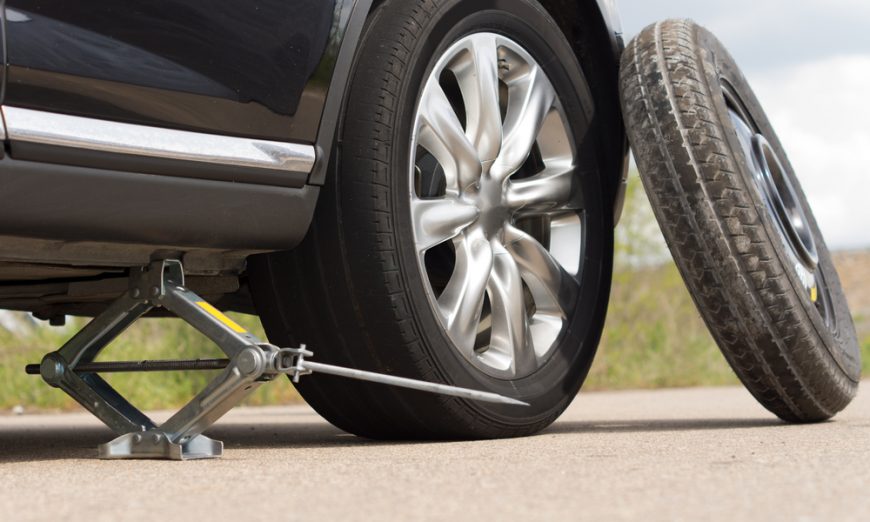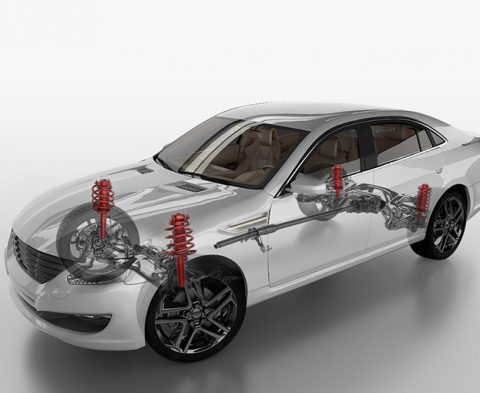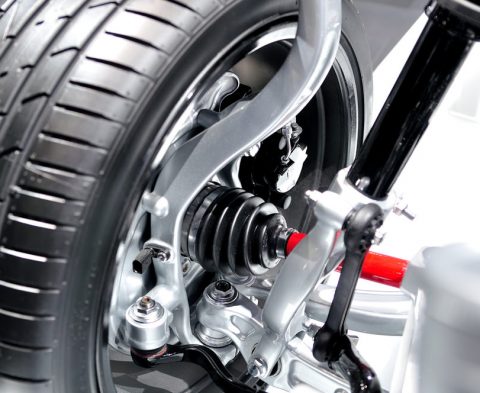
A spare tire or spare tyre is an additional tire carried in a motor vehicle as a replacement for one that goes flat, a blowout, or other emergency. Spare tire is generally a misnomer, as almost all vehicles actually carry an entire wheel with a tire mounted on it as a spare rather than just a tire, as fitting a tire to a wheel would require a motorist to carry additional, specialized equipment. However, some spare tires are not meant to be driven long distances. Space-savers have a maximum speed of around 50 mph. When replacing a damaged tire, placing the compact spare on a non-drive axle will prevent damage to the drivetrain. If placed on a drivetrain axle, the smaller-diameter tire can put stress on the differential causing damage and reducing handling.
You never know when you'll need to use your spare tire, but because it's out of sight on most vehicles it's usually out of mind, too. Even if the spare is mounted on the back of an SUV in full view, chances are it doesn't get the attention it deserves or the air pressure it needs. All tires lose air pressure over time because air permeates rubber. If a compact spare tire has been tucked away under a cargo floor for five years, there's a good chance it's severely underinflated and possibly unable to handle the load and stress of emergency road duty. An underinflated tire can't safely carry the same amount of weight as a fully inflated tire.
Compact spares typically should be inflated to around 60 pounds per square inch; one far short of that level could fail and damage the wheel as well. Even a fully inflated "doughnut" spare is designed only for temporary use, though, typically up to 100 miles at speeds no higher than 55 mph. Repair shops that perform tire rotations routinely check the inflation levels of the four tires on the vehicle, but the spare is usually ignored. To be safe, vehicle owners should ask that shops check the spare or do it themselves at least twice a year.
On SUVs and trucks that mount the spare on the liftgate or under the cargo area, long-term exposure to dirt, salt, water and snow can cause corrosion, and make it hard to remove the mounting hardware or operate latches and cables in an emergency. Periodic inspection, and cleaning or lubrication if needed, can make it easier to remove the spare when a tire goes flat. If your vehicle has a tire inflator kit instead of a spare tire, you could run into different issues. First, the sealant may not be able to seal all punctures, depending on their severity and location. In addition, the sealant that gets injected into the tire probably has an expiration date. The sealant might not work as well after that date, so it should be replaced.
Finally, if you're the kind of person who routinely drives with the trunk or cargo area loaded with unnecessary stuff, keep in mind that you'll probably have to remove all that stuff to get to the spare tire and jack, and then put it all back when you're done changing the tire. Moreover, a compact spare tire fits as snug as a bug and is out of sight, but a flat and usually filthy full-size tire and wheel won't fit into the same spot and will have to share space with all that stuff. Keeping a large plastic trash bag in the vehicle will allow you to transport a flat tire without dirtying the trunk or, potentially, the cabin.
Spare tires may not be mentioned on service menus at repair shops, but a little preventive maintenance can pay dividends when they're needed.
auto car fixing tire
 A spare tire or spare tyre is an additional tire carried in a motor vehicle as a replacement for one that goes flat, a blowout, or other emergency. Spare tire is generally a misnomer, as almost all vehicles actually carry an entire wheel with a tire mounted on it as a spare rather than just a tire, as fitting a tire to a wheel would require a motorist to carry additional, specialized equipment. However, some spare tires are not meant to be driven long distances. Space-savers have a maximum speed of around 50 mph. When replacing a damaged tire, placing the compact spare on a non-drive axle will prevent damage to the drivetrain. If placed on a drivetrain axle, the smaller-diameter tire can put stress on the differential causing damage and reducing handling.
You never know when you'll need to use your spare tire, but because it's out of sight on most vehicles it's usually out of mind, too. Even if the spare is mounted on the back of an SUV in full view, chances are it doesn't get the attention it deserves or the air pressure it needs. All tires lose air pressure over time because air permeates rubber. If a compact spare tire has been tucked away under a cargo floor for five years, there's a good chance it's severely underinflated and possibly unable to handle the load and stress of emergency road duty. An underinflated tire can't safely carry the same amount of weight as a fully inflated tire.
Compact spares typically should be inflated to around 60 pounds per square inch; one far short of that level could fail and damage the wheel as well. Even a fully inflated "doughnut" spare is designed only for temporary use, though, typically up to 100 miles at speeds no higher than 55 mph. Repair shops that perform tire rotations routinely check the inflation levels of the four tires on the vehicle, but the spare is usually ignored. To be safe, vehicle owners should ask that shops check the spare or do it themselves at least twice a year.
On SUVs and trucks that mount the spare on the liftgate or under the cargo area, long-term exposure to dirt, salt, water and snow can cause corrosion, and make it hard to remove the mounting hardware or operate latches and cables in an emergency. Periodic inspection, and cleaning or lubrication if needed, can make it easier to remove the spare when a tire goes flat. If your vehicle has a tire inflator kit instead of a spare tire, you could run into different issues. First, the sealant may not be able to seal all punctures, depending on their severity and location. In addition, the sealant that gets injected into the tire probably has an expiration date. The sealant might not work as well after that date, so it should be replaced.
Finally, if you're the kind of person who routinely drives with the trunk or cargo area loaded with unnecessary stuff, keep in mind that you'll probably have to remove all that stuff to get to the spare tire and jack, and then put it all back when you're done changing the tire. Moreover, a compact spare tire fits as snug as a bug and is out of sight, but a flat and usually filthy full-size tire and wheel won't fit into the same spot and will have to share space with all that stuff. Keeping a large plastic trash bag in the vehicle will allow you to transport a flat tire without dirtying the trunk or, potentially, the cabin.
Spare tires may not be mentioned on service menus at repair shops, but a little preventive maintenance can pay dividends when they're needed.
A spare tire or spare tyre is an additional tire carried in a motor vehicle as a replacement for one that goes flat, a blowout, or other emergency. Spare tire is generally a misnomer, as almost all vehicles actually carry an entire wheel with a tire mounted on it as a spare rather than just a tire, as fitting a tire to a wheel would require a motorist to carry additional, specialized equipment. However, some spare tires are not meant to be driven long distances. Space-savers have a maximum speed of around 50 mph. When replacing a damaged tire, placing the compact spare on a non-drive axle will prevent damage to the drivetrain. If placed on a drivetrain axle, the smaller-diameter tire can put stress on the differential causing damage and reducing handling.
You never know when you'll need to use your spare tire, but because it's out of sight on most vehicles it's usually out of mind, too. Even if the spare is mounted on the back of an SUV in full view, chances are it doesn't get the attention it deserves or the air pressure it needs. All tires lose air pressure over time because air permeates rubber. If a compact spare tire has been tucked away under a cargo floor for five years, there's a good chance it's severely underinflated and possibly unable to handle the load and stress of emergency road duty. An underinflated tire can't safely carry the same amount of weight as a fully inflated tire.
Compact spares typically should be inflated to around 60 pounds per square inch; one far short of that level could fail and damage the wheel as well. Even a fully inflated "doughnut" spare is designed only for temporary use, though, typically up to 100 miles at speeds no higher than 55 mph. Repair shops that perform tire rotations routinely check the inflation levels of the four tires on the vehicle, but the spare is usually ignored. To be safe, vehicle owners should ask that shops check the spare or do it themselves at least twice a year.
On SUVs and trucks that mount the spare on the liftgate or under the cargo area, long-term exposure to dirt, salt, water and snow can cause corrosion, and make it hard to remove the mounting hardware or operate latches and cables in an emergency. Periodic inspection, and cleaning or lubrication if needed, can make it easier to remove the spare when a tire goes flat. If your vehicle has a tire inflator kit instead of a spare tire, you could run into different issues. First, the sealant may not be able to seal all punctures, depending on their severity and location. In addition, the sealant that gets injected into the tire probably has an expiration date. The sealant might not work as well after that date, so it should be replaced.
Finally, if you're the kind of person who routinely drives with the trunk or cargo area loaded with unnecessary stuff, keep in mind that you'll probably have to remove all that stuff to get to the spare tire and jack, and then put it all back when you're done changing the tire. Moreover, a compact spare tire fits as snug as a bug and is out of sight, but a flat and usually filthy full-size tire and wheel won't fit into the same spot and will have to share space with all that stuff. Keeping a large plastic trash bag in the vehicle will allow you to transport a flat tire without dirtying the trunk or, potentially, the cabin.
Spare tires may not be mentioned on service menus at repair shops, but a little preventive maintenance can pay dividends when they're needed. A spare tire or spare tyre is an additional tire carried in a motor vehicle as a replacement for one that goes flat, a blowout, or other emergency. Spare tire is generally a misnomer, as almost all vehicles actually carry an entire wheel with a tire mounted on it as a spare rather than just a tire, as fitting a tire to a wheel would require a motorist to carry additional, specialized equipment. However, some spare tires are not meant to be driven long distances. Space-savers have a maximum speed of around 50 mph. When replacing a damaged tire, placing the compact spare on a non-drive axle will prevent damage to the drivetrain. If placed on a drivetrain axle, the smaller-diameter tire can put stress on the differential causing damage and reducing handling.
You never know when you'll need to use your spare tire, but because it's out of sight on most vehicles it's usually out of mind, too. Even if the spare is mounted on the back of an SUV in full view, chances are it doesn't get the attention it deserves or the air pressure it needs. All tires lose air pressure over time because air permeates rubber. If a compact spare tire has been tucked away under a cargo floor for five years, there's a good chance it's severely underinflated and possibly unable to handle the load and stress of emergency road duty. An underinflated tire can't safely carry the same amount of weight as a fully inflated tire.
Compact spares typically should be inflated to around 60 pounds per square inch; one far short of that level could fail and damage the wheel as well. Even a fully inflated "doughnut" spare is designed only for temporary use, though, typically up to 100 miles at speeds no higher than 55 mph. Repair shops that perform tire rotations routinely check the inflation levels of the four tires on the vehicle, but the spare is usually ignored. To be safe, vehicle owners should ask that shops check the spare or do it themselves at least twice a year.
On SUVs and trucks that mount the spare on the liftgate or under the cargo area, long-term exposure to dirt, salt, water and snow can cause corrosion, and make it hard to remove the mounting hardware or operate latches and cables in an emergency. Periodic inspection, and cleaning or lubrication if needed, can make it easier to remove the spare when a tire goes flat. If your vehicle has a tire inflator kit instead of a spare tire, you could run into different issues. First, the sealant may not be able to seal all punctures, depending on their severity and location. In addition, the sealant that gets injected into the tire probably has an expiration date. The sealant might not work as well after that date, so it should be replaced.
Finally, if you're the kind of person who routinely drives with the trunk or cargo area loaded with unnecessary stuff, keep in mind that you'll probably have to remove all that stuff to get to the spare tire and jack, and then put it all back when you're done changing the tire. Moreover, a compact spare tire fits as snug as a bug and is out of sight, but a flat and usually filthy full-size tire and wheel won't fit into the same spot and will have to share space with all that stuff. Keeping a large plastic trash bag in the vehicle will allow you to transport a flat tire without dirtying the trunk or, potentially, the cabin.
Spare tires may not be mentioned on service menus at repair shops, but a little preventive maintenance can pay dividends when they're needed.
A spare tire or spare tyre is an additional tire carried in a motor vehicle as a replacement for one that goes flat, a blowout, or other emergency. Spare tire is generally a misnomer, as almost all vehicles actually carry an entire wheel with a tire mounted on it as a spare rather than just a tire, as fitting a tire to a wheel would require a motorist to carry additional, specialized equipment. However, some spare tires are not meant to be driven long distances. Space-savers have a maximum speed of around 50 mph. When replacing a damaged tire, placing the compact spare on a non-drive axle will prevent damage to the drivetrain. If placed on a drivetrain axle, the smaller-diameter tire can put stress on the differential causing damage and reducing handling.
You never know when you'll need to use your spare tire, but because it's out of sight on most vehicles it's usually out of mind, too. Even if the spare is mounted on the back of an SUV in full view, chances are it doesn't get the attention it deserves or the air pressure it needs. All tires lose air pressure over time because air permeates rubber. If a compact spare tire has been tucked away under a cargo floor for five years, there's a good chance it's severely underinflated and possibly unable to handle the load and stress of emergency road duty. An underinflated tire can't safely carry the same amount of weight as a fully inflated tire.
Compact spares typically should be inflated to around 60 pounds per square inch; one far short of that level could fail and damage the wheel as well. Even a fully inflated "doughnut" spare is designed only for temporary use, though, typically up to 100 miles at speeds no higher than 55 mph. Repair shops that perform tire rotations routinely check the inflation levels of the four tires on the vehicle, but the spare is usually ignored. To be safe, vehicle owners should ask that shops check the spare or do it themselves at least twice a year.
On SUVs and trucks that mount the spare on the liftgate or under the cargo area, long-term exposure to dirt, salt, water and snow can cause corrosion, and make it hard to remove the mounting hardware or operate latches and cables in an emergency. Periodic inspection, and cleaning or lubrication if needed, can make it easier to remove the spare when a tire goes flat. If your vehicle has a tire inflator kit instead of a spare tire, you could run into different issues. First, the sealant may not be able to seal all punctures, depending on their severity and location. In addition, the sealant that gets injected into the tire probably has an expiration date. The sealant might not work as well after that date, so it should be replaced.
Finally, if you're the kind of person who routinely drives with the trunk or cargo area loaded with unnecessary stuff, keep in mind that you'll probably have to remove all that stuff to get to the spare tire and jack, and then put it all back when you're done changing the tire. Moreover, a compact spare tire fits as snug as a bug and is out of sight, but a flat and usually filthy full-size tire and wheel won't fit into the same spot and will have to share space with all that stuff. Keeping a large plastic trash bag in the vehicle will allow you to transport a flat tire without dirtying the trunk or, potentially, the cabin.
Spare tires may not be mentioned on service menus at repair shops, but a little preventive maintenance can pay dividends when they're needed.




